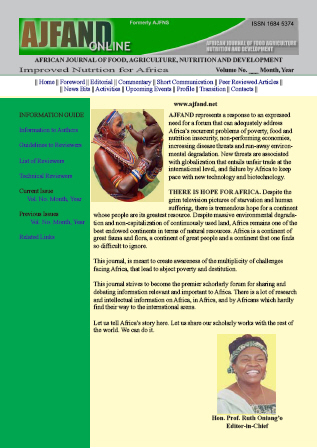
|
African Journal of Food, Agriculture, Nutrition and Development
Rural Outreach Program
ISSN: 1684-5358
EISSN: 1684-5358
Vol. 20, No. 3, 2020, pp. 15898-15918
|
 Bioline Code: nd20044
Bioline Code: nd20044
Full paper language: English
Document type: Research Article
Document available free of charge
|
|
|
African Journal of Food, Agriculture, Nutrition and Development, Vol. 20, No. 3, 2020, pp. 15898-15918
| en |
PROXIMATE COMPOSITION AND SERVING SIZES OF SELECTED COMPOSITE GHANAIAN SOUPS
Appiah, CA; Samwini, AM; Brown, PK; Hayford, FEA & Asamoah-Boakye, O
Abstract
Soups are major components of Ghanaian dishes. The composite nature of Ghanaian soups, in general, tend to make the calorie and macronutrient composition highly variable. This study sought to determine the proximate composition of selected Ghanaian soups from defined recipes and to photographically present quantities of the soups, measured with common Ghanaian household food measures, equivalent to servings of protein and carbohydrates. Two types of each conveniently selected soup (light soup, groundnut soup, kontomire (cocoyam leaves) soup and palm nut soup) were prepared; one with animal protein and the other without. The soups prepared include; LS1- light soup with garden eggplant (African eggplant); LS2- light soup with garden eggplant and chicken GS1- groundnut (peanut butter) soup without animal protein; GS2- groundnut soup with chicken; PS1- palm nut soup without animal protein; PS2- palm nut soup with smoked catfish and herrings. Proximate analysis was done to determine macronutrient content of all the soups. Each soup was measured using a household food measure (150 ml soup ladle) to obtain a 15 g carbohydrate and 7 g protein equivalent and then photographed. Carbohydrate content of the soups ranged between 1.18 g-8.43 g, protein was between 0.34 g-4.31 g and 0.14 g-7.78 g for fat per 100 g of edible portion. Palm nut soup with animal source protein had the highest carbohydrate (8.43 ± 0.86 g) and fibre (1.99 ±0.22 g) content. Soups with the highest protein and fat content were GS2 (4.29 ± 0.14 g) and PS1 (20.39 ± 3.54 g) respectively. Serving sizes of the soups prepared ranged approximately between 1-8½ soup ladles (using 150 ml soup ladle) per 15 g carbohydrate equivalence and 1-13 soup ladles (using 150 ml soup ladle) per 7 g protein equivalence. It took variable quantities of the prepared soups to obtain the target serving sizes with PS2 having the least quantity (~1 soup ladle) for 15 g carbohydrate serving and PS1 having the least amount (~1 soup ladle) for 7 g protein serving. The large serving size of most of the soups required to meet a serving of protein implied that those soups should be eaten together with food sources rich in protein, in order to appreciably enhance the protein intake of individuals.
Keywords
Composite Ghanaian soups; serving size; protein; carbohydrates; fats; proximate composition
|
| |
© Copyright 2020 - African Journal of Food, Agriculture, Nutrition and Development
Alternative site location: http://www.ajfand.net/
|
|
